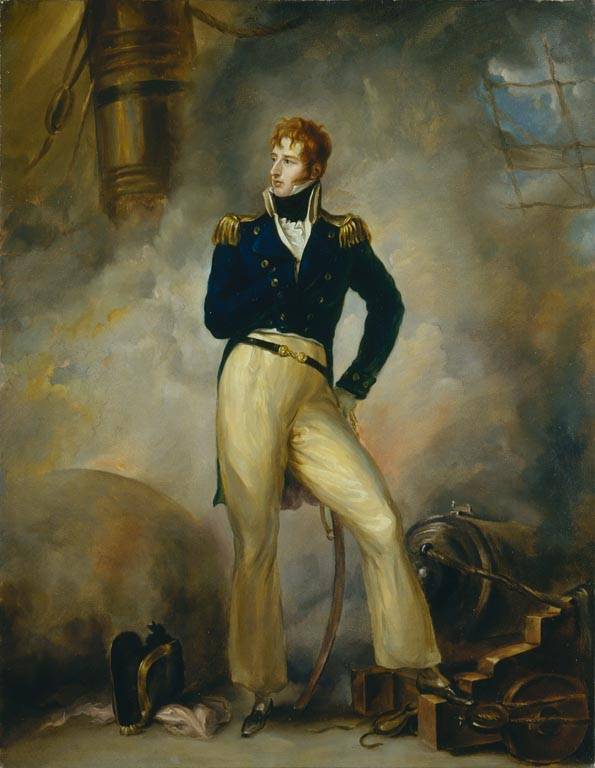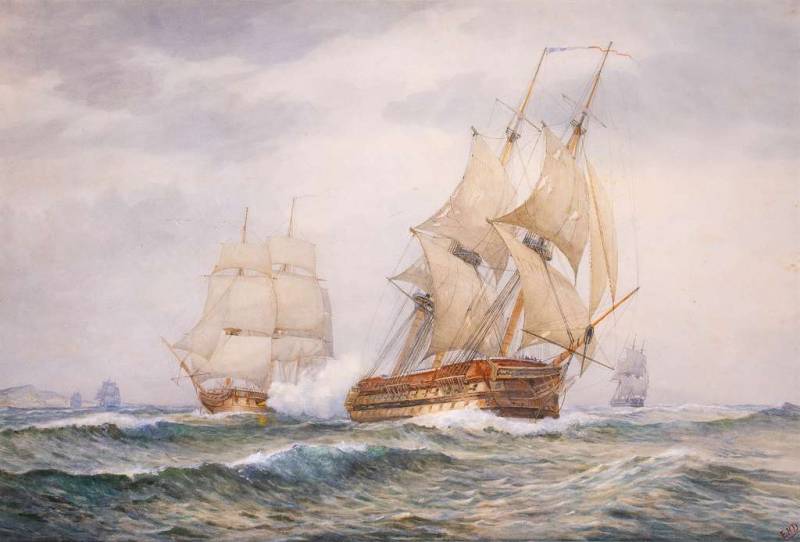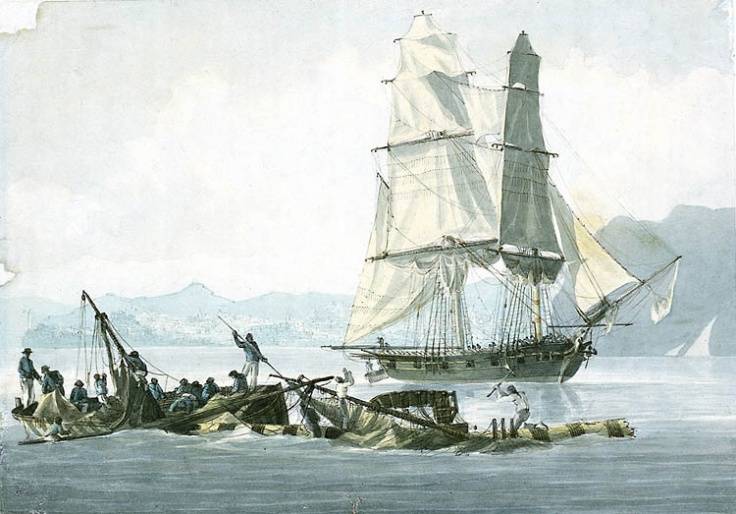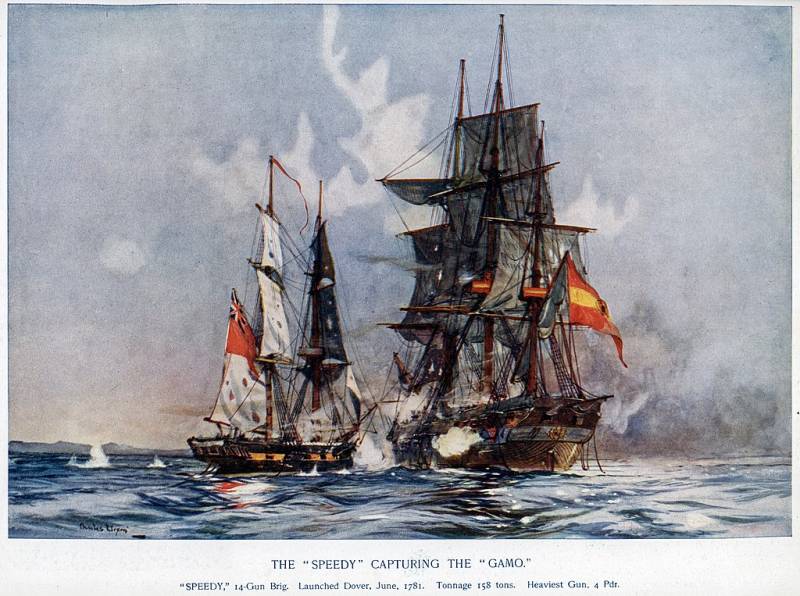David vs Goliath

Thomas Cochrane
At the beginning of glorious deeds
The name of Thomas Cochrane is known to every fan stories sailing fleet. It was from him that the British marine painters wrote their heroes, such as Horatio Hornblower or Captain Jack Aubrey. However, the real Lord Cochrane was a much more complex and controversial figure.
Thomas Cochrane was born December 14, 1775 in Ansfield, South Lanarkshire, Scotland. Among his relatives were admirals (Alexander Cochrane, Thomas John Cochrane) and generals (Andrew James Cochrane).
It is clear that with such relatives, the career of a young rake should have gone easily. Moreover, his uncle, Alexander, enrolled Thomas on his ship as a cabin boy at the age of five, so that by the time he came of age, the guy could come to the fleet as an officer. This practice, called "false list" (false muster), was ubiquitous in the British fleet of the late XNUMXth - early XNUMXth centuries.
However, one should not be surprised, because, for example, in Russia, this is quite practiced. Recall that the great Alexander Vasilyevich Suvorov was enlisted as a musketeer in the Semyonovsky regiment at the age of 12, but he joined the army only at 17.
In the same way, everything happened to our hero, because at the age of 17 he came as a midshipman to the 28-gun frigate Hind, which ... was commanded by his uncle Alexander Cochrane. Two years later, Thomas passed the lieutenant's examination and was appointed 8th lieutenant on the 90-gun ship of the line Barfleur, commanded by Lord Keith.
It would seem that a career is secured, what can go wrong?
However, it was on Barfleur that Thomas Cochrane's character first emerged.
So, the ship arrived in the Mediterranean in 1798, Lord Keith immediately moved to the admiral's position, becoming the head of the Mediterranean fleet instead of the departed Lord St. Vincent, but at the same time, Barfleur's first lieutenant Philip Beaver ... did not receive a promotion. Keith did not make him a captain, appointing him a commander, that is, an interim captain of the ship.
The fact is that English ships, cruising the Mediterranean Sea, quite often called at Tetouan for provisions, in particular, they took on board cattle - bulls, cows, sheep. Beaver, a man from a poor family, ordered the raw skins of slaughtered animals to be carefully stored in the hold for subsequent resale in Spain or England, and soon, due to the fetid smell of rotting meat residues, it became impossible to enter the lower decks at all. It was Cochrane who suffered the most from this, whom Beaver made responsible for the warehousing and preservation of these skins.
So, in one of the skirmishes with Beaver, Cochrane had the audacity to say that “those who are engaged in the speculation of raw skins on this smelly Scottish ship (Stinking Scotch Ship), for some reason, are very unfriendly towards me”. As a result, an angry Beaver initiated a trial, Cochrane got off with a fine.
In 1800, Thomas and his brother Archibald towed the damaged French battleship Genereux, captured by Nelson, to their base in Menorca. During the transition, the ship fell into a storm, both Cochranes climbed onto the masts, like simple sailors, since there were absolutely not enough hands, and managed to save the ship and bring it to its destination.

French 74-gun ship Genereux
It would seem - well, here are the real achievements. Perhaps your career will go up?
But Sir Thomas wouldn't be Sir Thomas if he hadn't gotten into something scandalous again.
1801, Malta, already captured by Napoleon. Cochrane, among other young officers, was invited to the ball and decided to go to it in the clothes of an ordinary sailor. At the entrance, he was intercepted by a French officer who was doing the work of a porter, and said that it was impossible to enter the ball in this form. Moreover, mistaking Thomas for a sailor, he accompanied his words with a blow from the sheath of his sword below the back. Thomas, without hesitation, charged the Frenchman with a hook from the left, and contemptuously threw Merde. The next day, a duel took place, where Cochrane shot the Frenchman in the thigh, while the enemy's bullet slightly wounded Thomas in the side.
Brig Speedy
After this incident, Keith and the leadership of the fleet wanted to get rid of the Scots brawler as soon as possible, urgently made him master and commander (a rank intermediate between lieutenant and captain) and gave Thomas the command of the 14-gun brig Speedy, hoping that he would perish together with him off the Spanish coast.
The armament of the brig consisted of miserable 4-pounders and twelve half-pounder shotguns on deck superstructures. Cochrane himself described the brig as "nothing more than a parody of a warship". I must say that here Sir Thomas was a little cunning - earlier Speedy under the command of Cockburn, Downman and Brenton had already become a bone in the throat for the French and Spaniards. Yes, the boat was slow, the one who called it Speedy (“Fast”) had a perverted sense of humor, but it was quite suitable for reconnaissance and cruising. However, Cochrane managed to get a spar from Genereux and lengthened the masts, making the brig faster.

Brig Speedy[/ Center]
For five months in 1800, Speedy simply tormented the coast of Italy and was transferred by Keith to the coast of Spain to disrupt coastal shipping there. For two months, Cochrane almost completely paralyzed traffic between Malaga and Alicante, and became such a thorn in there that the Spaniards decided to start a real hunt for Cochrane. Anticipating this, the English lieutenant decided to use the art of disguise.
After a couple of days of work, it was not His Majesty's brig Speedy that was born, but quite a decent Danish trading brig Clomer, which was given a team that spoke Scandinavian dialects (thanks to the Norwegians and Swedes in the Speedy crew), the Danish flag, the coloring characteristic of the Baltic.
On December 21, 1800, Clomer ended up near Barcelona and was immediately blocked from the coast by 7 Spanish gunboats, and from the sea by the 32-gun Spanish xebec frigate El Gamo. There was something to lose one's head about, but Cochrane kept it clear enough - first of all, he greeted the Spanish boarding parties in a mixture of Danish-Norwegian dialect, and then pointed to a yellow banner fluttering over the brig - the Spaniards, seeing the yellow flag, fled from the ship in horror.
The fact is that the yellow flag was raised during an epidemic on ships - plague, cholera, dysentery, fever - all these diseases most often got ashore from ships. To protect the population of the ports from the epidemic, the ships raised the yellow flag and quarantined at sea for one month after the death or recovery of the last patient.
Naturally, the gunboats and the frigate got away with all possible speed, and Speedy continued cruising.
At the end of March 1801, Cochrane was almost caught with a prize at Port Mahon by a Spanish frigate, the night was already close, but the Spaniard was inexorably approaching, and as soon as it got dark, Cochrane ordered a small raft with a copy of the ship's mast to be lowered from the brig. On a signal, the top lights on the brig were extinguished, and on the raft they were lit. As a result, El Gamo chased the raft, and Cochrane freely headed 4 points south and came to Menorca with a prize.
David vs Goliath
Finally, the climax came on May 5, 1801.
On this day at Barcelona, Speedy started a fight with 6 rowboats and safely passed them, aiming further for the fishing schooners, when the 32-gun El Gamo left the harbor. It was a frigate-shebeka, that is, by appointment - a cruiser, but with sailing armament of a shebeki. It carried 12-pounder guns, plus two 24-pounder howitzers. The crew was 319, compared to 54 for Cochrane.
By all canons, the British had no chance. And Lieutenant Cochrane decided to fight, moreover, to board. Despite all the adventurism of this approach, the plan was quite well thought out.
The fact is that a fairly fresh wind was blowing from the south, and Speedy was relative to El Gamo from the north. The lower deck of the frigate was tilted towards the water, and could not be used at long and medium range, so the Spaniard could fire at Speedy only by moving (but this threatened that the brig could escape), or at close range.
To confuse the Spaniard, Cochrane ordered the American flag to be hoisted and steered the ship straight towards the frigate. The Spanish captain, rubbing his hands, waited for the brig to come closer, but at the last moment Cochrane put the rudder to the right and cut off the stern of the xebec. The flag of St. George was hoisted on the mizzen, and the Spaniard received a longitudinal volley of seven 4-pounders (2-3 cores were packed into the cannons), which did not harm the hull, but damaged the rudder.
The Spaniard turned sideways and fired a volley, but the brig was already in the dead zone - the balls passed above the ship's hull. Cochrane seemed to stick to the Spaniard - all attempts to move away and cover the already insolent cloud of cores had absolutely no success. The Spaniards fired frequently, but their cannonballs flew higher - it was impossible to lower the gun beds down.
Such a game lasted three hours - Cochrane resembled a dog that grabbed a bear by the butt - you can’t eat it, but if you let it go, there will be no pieces left from the dog. He could not retreat, knowing full well that as soon as he was within range of El Gamo's guns, the brig would be smashed to pieces.

The brig Speedy vs. the frigate El Gamo
There was a boarding, but at first glance it was an even more stupid decision - after all, the advantage of the Spaniard in people was 6:1. Nevertheless - Cochrane decided to go for broke.
He ordered the team to rub their faces with a cork (for some reason, believing that the Spaniards would be more afraid of blacks than whites) and divided his already meager forces. He took 20 people under his command into the boat for disembarkation from the side of the bow of the xebec, the rest were to disembark from the stern.
The Spaniards, seeing the boats approaching the bow, concentrated the entire crew there. Cochrane met fierce resistance, and, of course, his detachment would have been killed, but at that moment the crew remaining on Speedy fired a broadside from the stern and went to board from the quarterdeck.
The Spaniards, caught between two fires, panicked. They thought that there were many more people on the English brig than there actually were. After 20 minutes on El Gamo, the Spanish flag was lowered, and the flag of St. George climbed up.
Even more surprising are the losses - 3 killed and 18 wounded by the British, and 15 killed and 41 wounded by the Spaniards.
There is a story that the captain of El Gamo asked Cochrane to sign on his report that he was not to blame for the surrender of the ship and did everything possible. Cochrane, without thinking twice, wrote sweepingly: “Fought like a real Spaniard!” You don’t understand whether you praised or scolded.
After battle
Cochrane's thirteen-month voyage soon came to an end on July 3, 1801, when three French ships of the line under the command of Admiral Charles-Alexandre Linois captured it. French captains often turned to Cochrane for advice.
The Scot later recalled how polite and courteous the French were before he was traded for a French captain in August:
But what about El Gamo?
Newspapers raged, glorifying Cochrane, but soon there was silence, full of bewilderment, when they learned that El Gamo was not purchased by Royal Nevi in its ranks, but presented to ... the ruler of Algeria, and the prize money to Speedy sailors was paid at the residual value (supposedly the frigate during the battle Suffered).
Moreover, Cochrane was not given the title of captain for this fight, although by all the canons he deserved it. Most likely, in this case, as in others, Cochrane could well thank his long tongue. But the fight, of course, he fought beautifully. Very beautiful.

El Gamo before surrender
He returned to the Cochrane fleet already in 1803, where, as if in mockery, he was given command of the 22-gun sloop Arab, which, in the figurative expression of Sir Thomas, "could somehow swim only sideways", however, even on such a sloop Cochrane showed himself as an excellent sailor. But that's a completely different story.
Bibliography:
1. James, William "The Naval History of Great Britain", Volume 5, 1808-1811 - London: Conway Maritime Press, 2002 (1827 reprint).
2. Clowes, William Laird "The Royal Navy, A History from the Earliest Times to 1900", Volume V - London: Chatham Publishing, 1997 (1900 reprint).
3. Julien Lafon "Histoire des brûlots de l'île d'Aix" - Paris, Aymot, 1867.
4. Harvey, Robert "Cochrane: The Life and Exploits of a Fighting Captain" - London: Constable, 2000.
Information